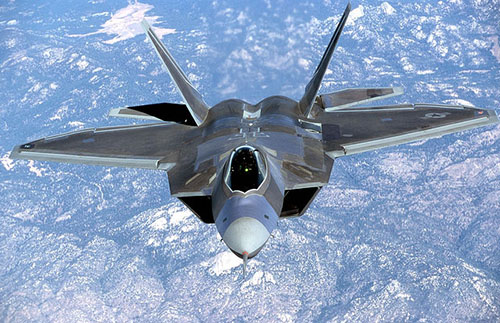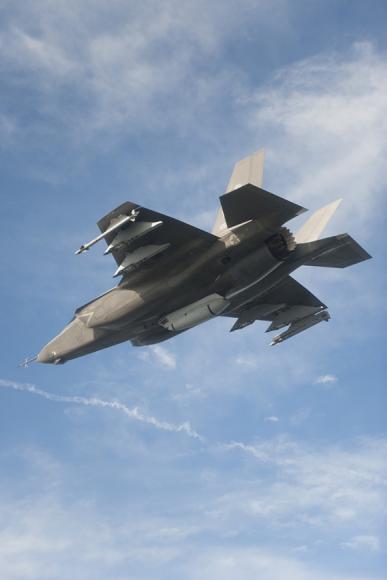Why is the F-35B, a system declared ready for war (albeit with an Initial Operating Capacity), not in Syria? It is an answer that the experts know well. The clash in Syria has become a huge stage to show its strength. The US has practically deployed the best of their aviation. So did the Russians, French and English. They demonstrated (not that it was needed) their ability to targeting (the second of the planet) also the Israelis.
But, one wonders, where are the F-35B of the Marine?
Despite being operational since last 31 July, there is no trace of the fifth generation fighter. And to say that the Pentagon in Syria has sent its precious ones Raptor (photo below). While there was no aerial threat or significant defense systems, the Air Force deployed its best platform into the fray. It was in some ways the baptism of fire for the F-22 since its entry into service nearly eleven years ago. Il Raptor, as repeatedly reaffirmed by the Pentagon, is proving essential in Syria.
A few hours ago, the White House decided to risk even twelve A-10s in Turkey Warthog (to support the special departments) and twelve F-15C Eagle (superiority fighter with exclusive air weaponry).
There is no trace of the F-35B. Its sensors would not be essential, in theory even higher than those supplied by the Raptor? The answer is simple: the $ 1500 billion program has not yet put a truly battle-ready platform online. Reliability problems first of all (as detected by DOT & E last September) and those tests that took place in unrealistic conditions. The seven F-35Bs aboard the USS Wasp they did not transport a single bomb, they were later deployed with the rest of the USS Wasp Air Combat Element (ACE).
A passage from the report was noteworthy: "Although the Marine had quick and easy access to the spare parts and were supported by the contracted boarding staff, the reliability proved to be rather poor. of three F-35Bs a day. "Considering an operational context, maintenance could take place (indeed almost certainly) with greater difficulty.
We know that unlike the V-22 Osprey, which the Marines deployed in Iraq immediately after the 'IOC', the F-35 was never designed to enter the war with the Islamic State. The first squadron of VMFA-121 should be transferred to the base of Iwakuni, Japan, in January of 2017, to respond to possible crises in the Region. Despite everything, the official version of the Marine is the same as always: "it's ready for battle".
The Marine Corps with the F-35B reached the Initial Operational Capability with the 2B software block. The 2B bestows Close Air Support with the possibility of launching AMRAAM (Advanced Medium Range Air to Air Missile), JDAM (Joint Direct Attack Munition) and GBU-12 (laser-guided aerial bomb). It is not equipped with a cannon or better: the software for its operation will be ready in two years. The ten F-35Bs of the Marine are equipped with a special version of Block 2B software. The Marine Squadron, called the '1 Group', presents most of the hardware modifications already implemented (and which will be integrated into mass production tomorrow) like the reinforced bulkheads. The aircraft could go into battle, but with a 'reduced' equipment: AIM-120 AMRAAM missiles, GBU-12 and GBU-39 bombs.
 But if it were really operational and ready, why not deploy it to support the Raptor?
But if it were really operational and ready, why not deploy it to support the Raptor?
2443 F-35 will cost 400 billions of dollars in single acquisition. The words of former Defense Secretary Donald Rumsfeld return to memory: "You go to war with the army you have, not with what you want".
Or maybe, that problem on sharing data collected by fighters in the configuration of four aircraft, is not yet compatible with the war?
The Marines are forced to fly in 2 + 2 fighter formations. The merging of data on threats detected by a team made up of four fighters is not well managed by the current software. As a result, the F-35 has some difficulties in identifying the actual number of enemy targets on the radar. Better, then, make them fly in pairs. Problems have been identified in the collective 'merger' of detected threats, one of the strengths of the 'Game Changer' future. The data transmitted to pilots, sometimes, are not the real ones. Lockheed Martin will solve the problem with the 3F software block. The Marines, therefore, will fly the F-35 in pairs instead of four. This configuration has shown greater reliability and low levels of false alarms, absolutely manageable.
Why is not the F-35B in Syria?
(photo: Lockheed Martin)












